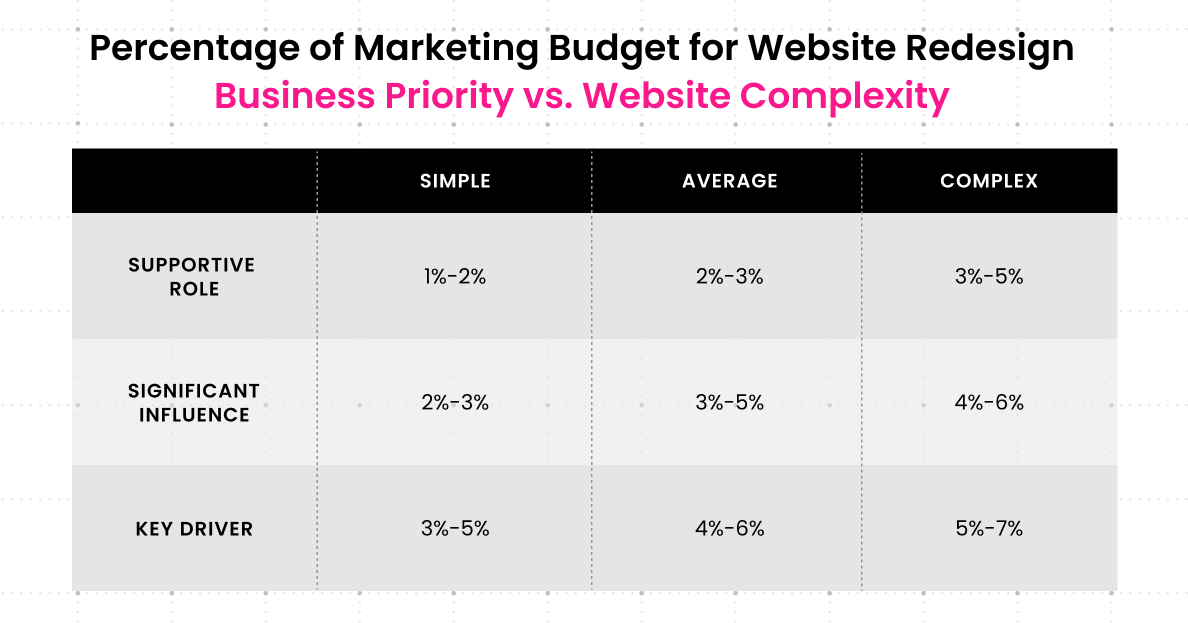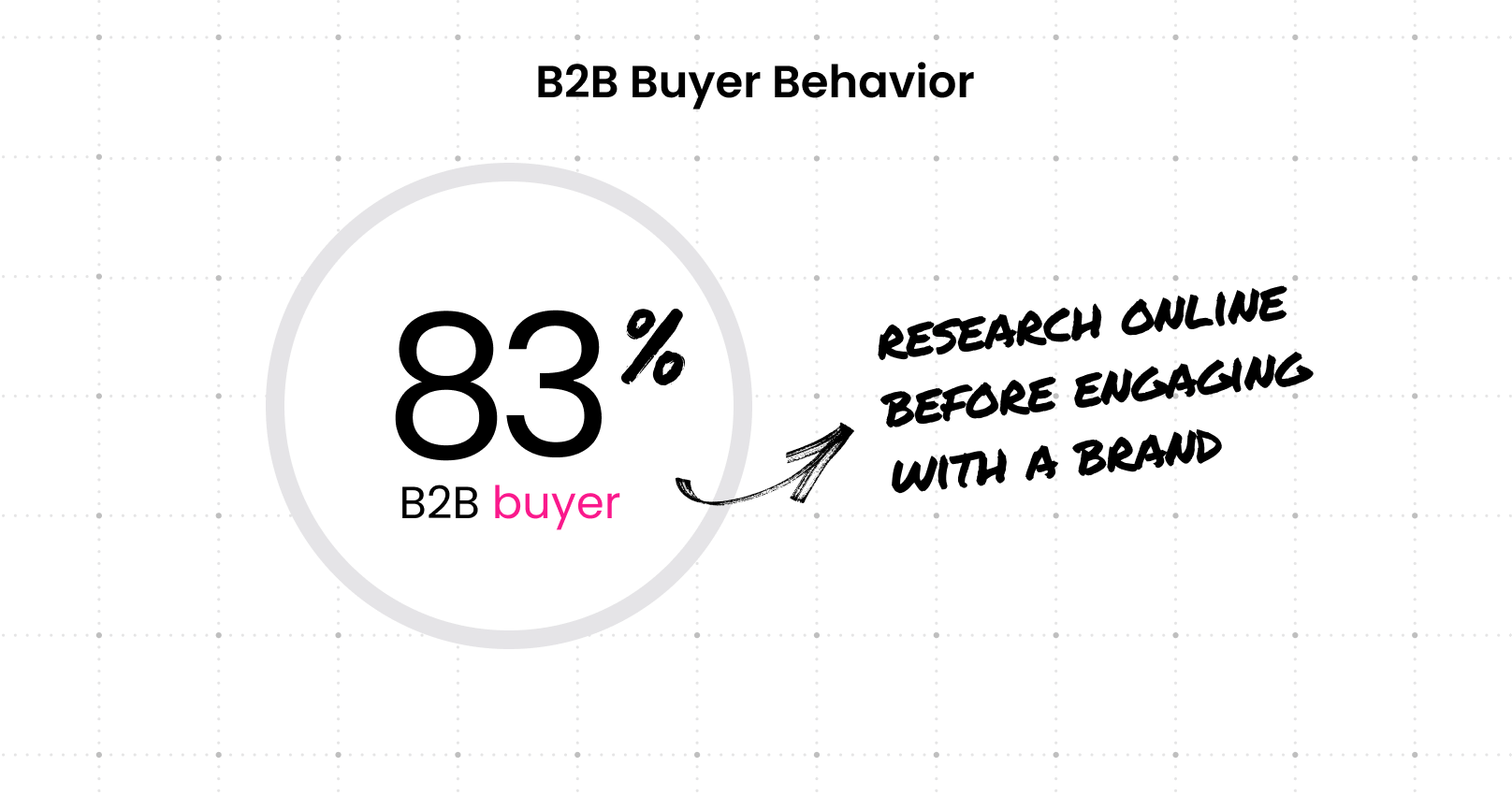For B2B businesses, your website is a key driver of growth. Not only is it your face to the world, it’s often the first place that potential customers interact with your brand. As such, keeping it up-to-date and on-point with the latest digital trends as well as your own internal messaging is critical to both short-term and long-term success. That means regular redesigns are table stakes.
Website Budget Calculator
Determine how much of your marketing budget to allocate for a successful website redesign.
However, many businesses struggle with allocating the right budget for a website redesign amidst competing marketing channels. Conducting online research may lead you to arbitrary answers—but every business is different, and many factors influence accurate budgeting for this sizable undertaking.
Let’s look at how B2B brands can strategically calculate the right investment level and maximize ROI for your website redesign using key factors that are often overlooked: company revenue, business priorities, and website complexity.
Today’s challenges for B2B websites
We live in a time of rapid change, with ongoing economic and technological disruptions constantly reshaping marketing strategies. To keep up, you need a website that can easily adapt to evolving needs—which requires regular updates.
The top marketing pain points we’re seeing with our B2B clients when it comes to keeping their websites fresh include:
- The rise of AI: In 2024 and 2025, everyone is adding AI to their solutions. As these products roll out, website information architecture and user journeys must be updated to telegraph the true value of these innovative offerings.
- Shift from product to platform-based solutions: As platforms become the norm, simplifying complex solutions and engaging users calls for enhanced content strategies and more visual storytelling.
- Economic pressures: Ongoing global economic woes forcing tighter budgets and reduced spending are also pushing companies to focus on lead generation and sales. Website optimization is essential to driving conversions.
- Competitive pressures: As market competition increases, brand success hinges on stronger positioning and differentiation. To stand out, your website must excel in both messaging and user experience.
The challenge of budgeting for website redesign
Despite knowing how important B2B websites are, many companies are still unsure how to allocate the right portion of their marketing budget for redesigns. As this is a fairly major project that needs to be done every two to four years, figuring out how much to carve out of your marketing budget is essential.
So, what stands in the way? We often see clients struggling with:
- Competing priorities: With marketing budgets often spread across numerous channels, it can be hard to allocate enough resources to support the kind of comprehensive website overhaul that’s required to keep up in today’s digital landscape.
- Longer investment cycles: As a project that doesn’t have to be undertaken annually, it can be challenging to estimate how much to invest in a redesign. After all, you won’t need to repeat it for a few years if done right, so how much should you spend right now?
- Justifying short-term ROI: Although we know websites are critical drivers of sales and growth, it can be harder to demonstrate the immediate ROI of a website investment compared to other marketing efforts. This makes it harder to make the business case for your budget, especially if it’s substantial.

Start by understanding your website’s strategic business value
here’s no hard and fast rule about how much you should spend. Many factors play a role in determining an optimal investment for a website redesign. The first step to figuring out how much you should allocate is to establish what role your website plays in your company’s revenue generation strategy.
Having worked with B2B companies of all sizes for almost 25 years, we can divide this role into three broad brush categories:
- Supportive role: For companies where the website contributes minimally to revenue generation, the website is a lower priority—and a smaller investment may suffice.
- Significant influence: If your website isn’t the main revenue driver for your business but still contributes significantly, the budget allocation should reflect its importance as a medium-level priority.
- Key revenue driver: If your website is central to revenue generation and profitability, a substantial investment is needed to ensure this high-priority asset drives sales and supports business growth.
Next, evaluate your website’s complexity
Not all websites are created equal, and your budget should reflect your website and brand’s specific needs. Understanding the complexity level required for a website redesign is critical to determining the right budget—but it’s often overlooked.
The scope of digital needs plays a key role in website complexity and sophistication:
- Simple: A basic redesign or new build using a no-code platform with minimal features and a straightforward design is suitable for companies with basic digital needs.
- Average: For growing digital needs, opt for a moderate redesign using a CMS platform like WordPress or Drupal, with custom features and enhanced user experience.
- Complex: Websites with highly complex needs will require a comprehensive build or redesign using DXP or custom databases with intricate designs, advanced features, and full-system integrations.
Other things to think about when allocating your website budget
A number of other factors influence budget requirements for a successful redesign. When determining how much to allocate, be sure to keep these things in mind, too:
- Content development needs: A lot goes into building a website that hits your performance goals. In addition to a skilled technical build, you need compelling copy and eye-catching images that tell the right story. Other key elements including infographics, animations, and videos are also key to communicating complex content and making sure your brand message lands. All of these things should be high quality—so be sure to include them in your budget.
- Compliance requirements: Depending on your industry, your website may also need to meet legal and regulatory requirements, such as GDPR or HIPAA, for example. This can require additional investment—especially as these regulations are often stringent and updated regularly. Ensuring ongoing compliance is critical to protect your brand reputation as well as avoiding costly fines.
- Infrastructure, licensing, and scalability: Be sure to account for future growth needs when determining your website redesign budget. Build your website on infrastructure that supports these needs via cloud hosting, licensing costs, and scalability, which can significantly influence overall costs.
Putting it all together: Determining the right budget for your website
Finally, consider how your website budget fits into your broader marketing strategy. According to Gartner, marketing budgets typically equate to 5-10% of revenue. This should give you a baseline range for determining your website budget.
Factor in its revenue-generating role (supportive, influential, critical), overall complexity, and the other key considerations that can significantly impact costs, and you should be able to land on a figure that makes sense as part of your larger marketing budget.
The table below provides some guidelines for budgeting based on the various factors we’ve covered. Bear in mind, however, that this budget is wholly allocated for website redesign—you’ll also need to set aside budget for website maintenance and other projects.

Setting the stage for growth
Allocating the right budget for your website redesign lays the foundation for long-term business success by aligning with your strategic goals and digital needs. It’s all about finding the right balance:
- Think about both immediate business priorities and long-term growth goals.
- Balance short-term user needs with the need to scale your support and optimization strategy in the future.
- Adopt a data-driven approach and take advantage of purpose-built tools, like Clear Digital’s budgeting calculator to allocate your resources for maximum ROI.
Want to know your optimal website redesign budget? Check out our budgeting calculator. And if you’re ready to redesign your website for maximum digital performance and ROI, we’re ready to help.







